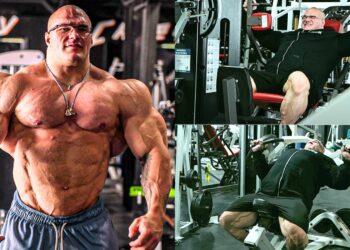The cross-body crunch is an excellent bodyweight exercise that targets the muscles that make up the core. It can help to improve the six-pack muscles, strengthen the midsection, and improve the flexibility and mobility of the hips. Having a strong, functional core is essential if you want to build a strong, muscular body and it can help to prevent injury. This is a great exercise to add to your core training arsenal that almost anyone can do safely and effectively.
In this article, we’ve explained how to do it with tips, variations, and how to include it in your workout routine.
Here’s a guide to the cross-body crunch…
Muscles Worked
Cross-body crunches can be incorporated to improve the development of your midsection muscles. Learn about their anatomy below.
Obliques
The obliques are located on either side of the rectus abdominis and consist of the internal and external obliques that are considered part of the core group of muscles. The function of the obliques is trunk rotation and lateral trunk flexion.
The cross-body crunch involves rotation of the trunk as it’s a knee to opposite elbow movement.
Level Up Your Fitness: Join our 💪 strong community in Fitness Volt Newsletter. Get daily inspiration, expert-backed workouts, nutrition tips, the latest in strength sports, and the support you need to reach your goals. Subscribe for free!
Rectus Abdominis
Crunches are an abdominal core focused exercise which means most people do them to have a better looking midsection and ideally create a six pack. The rectus abdominis or external abs function to curl the torso or bend it up like during crunches.
Hips
While not the primary focus in the cross-body crunch, the hips are involved in flexion and adduction of the thigh (toward the midline of the body) during this exercise. The hips consist of the glutes and inner thigh muscles. Although there’s no real resistance to significantly strengthen these muscles during the cross-body crunch, it can help to improve mobility and flexibility.
The hip flexors can take over during crunches which, is not ideal and that’s why it’s important to develop a strong core.
How To Do The Cross-Body Crunch
The cross-body crunch is a rather simple exercise but it’s a little more challenging than the basic abdominal crunch although not by much unless you have severely restricted hip mobility. Here are step-by-step instructions for the cross-body crunch.
- Lie face-up on the floor with your knees bent so that your feet are flat on the ground.
- Gently place your fingers behind your ears so that your elbows are pointing laterally away from your body as shown in the video.
- To do the cross-body crunch, tense your midsection to keep your core muscles tight, then bring your left elbow and right knee together directly above your belly button. You want to twist your trunk to meet the elbow to the knee.
- Return to the starting position and repeat with the right elbow and left knee.
- Complete the desired number of reps by alternating.
Here’s a video example…
Cross-body crunch tips
- Never pull on your head while performing any variation of a crunch; this is both dangerous and improper execution of the exercise.
- You want to keep your core tense the entire time you’re performing this exercise. This ensures that your abs are maximally engaged, and prevents excessive rounding of the back.
- Use a moderate tempo to ensure you’re maintaining tension on the core. You want to keep the set going to really feel the burn and challenge the muscles.
- Make sure to rotate your trunk as you curl up to engage the obliques.
- You want to bring the elbow and knee together at the same time to maximize the muscle contraction of the midsection.
- Don’t just drop back down to the mat; slowly return yourself to the starting position during the negatives to keep the tension on the core.
Related: Train Your Obliques For A Killer Core
3 Variations
There are so many different variations of the crunch with the cross-body crunch being one. But there’s also variations of the cross-body crunch that involve trunk rotation and lower-body involvement.
Hanging oblique knee raise
This is a more difficult exercise than the cross-body crunch because the heavy weight of the legs is used as resistance with the body hanging from a bar. You want to do these nice and controlled to avoid swinging which defeats the purpose of the exercise. Also, you want to lift the legs above 90 degrees to maximally contract the obliques but it’s also a great way to strengthen the hip flexors.
Level Up Your Fitness: Join our 💪 strong community in Fitness Volt Newsletter. Get daily inspiration, expert-backed workouts, nutrition tips, the latest in strength sports, and the support you need to reach your goals. Subscribe for free!
To do it:
- Hang from a bar and make sure to keep your shoulders down and un-shrugged to prevent your head from sinking into your neck.
- Twist to one side, bend your hips and knees and raise your legs as high as you can while contracting the core muscles. The idea is to curl the pelvis up to expose the glutes and not just to raise the legs to 90 degrees.
- Return to the starting position but don’t fully extend your legs.
- Rotate to the other side and repeat.
You can also use a captain’s chair/power tower if this variation is too challenging.
Lying bent-knee oblique twist
This lying bent-knee oblique twist only involves lower body movement to facilitate rotation of the trunk. It’s also a very simple exercise that most people can do regardless of experience level.
Russian twist
The Russian twist is a phenomenal exercise and one of the most popular for working the obliques. You can do it with or without weight but if you want a jacked core; make sure to include this one in your routine.
The cable Russian twist is also an amazing exercise for building the obliques.
How To Incorporate The Cross-Body Crunch Into Your Training Routine
The cross-body crunch is a core exercise and should be incorporated into your exercise routine accordingly… alongside your other core movements. But it also makes for a perfect standalone core exercise that you can do on days when you’re lying around and want to crank out a bunch of reps to really challenge yourself.
But if you have access to a gym, then we’d recommend you be a little strategic about how you train your abs for best results.
We’d suggest starting with a hanging leg raise variation because they are typically more challenging due to the heavy weight of the legs. The cross-body crunch should be the next exercise that you do because it involves the engagement of both the upper and lower body working together. After that, something like a basic crunch is ideal because it focuses on just the upper half movement. Then a good way to end your workouts is to utilize a standing core exercise to emphasize the functional aspect of training your midsection.
Sets/reps
For the cross-body crunch, it’s best to take your sets to failure because it’s honestly not the most challenging exercise that you can do. It’s more of a basic variation and you want to get the most out of it each time you include it in your routine because, at some point, this exercise will become too easy. When this happens, you’ll want to choose a more advanced variation to continue making progress.
3-4 sets to failure should be sufficient.
Wrapping Up
The cross-body crunch is a great basic core exercise that anyone can do to improve their midsection. Not to mention, it only requires your body weight and a soft surface which means it can be done almost anywhere. It’s more of a beginner variation but you can definitely scale up if needed with any of the variations provided.
Related: The Cable Side Crunch Exercise Guide and Videos
Interested in measuring your progress? Check out our strength standards for Side Crunch, Russian Twist, Hanging Leg Raise, and more.








